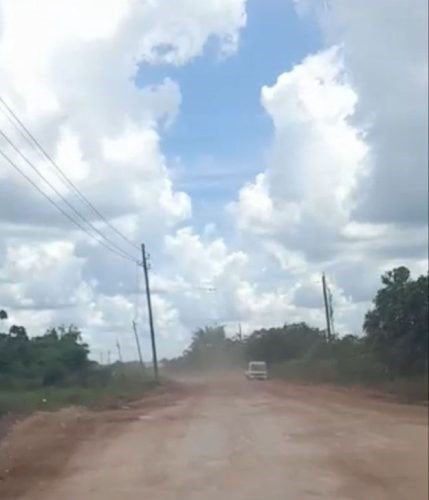The Ministry of Public Works has denied the claim by the Linden Mayor and Town Council and published by this newspaper yesterday, that the access road at Nooitgedacht poses a toxic threat to residents of the area, though it has not yet conducted independent testing of samples.
In a statement released yesterday via its official Facebook page, the ministry wrote, “… the claims made in this article are misleading. The information referenced is inaccurate, and there is no evidence of a toxic threat to the residents of Linden resulting from the materials used on the … road.” The statement skirted the fact that the materials used on the road were tailings from a disused aluminium plant.
The ministry stated that the report cited by Mayor Sharma Soloman, which pointed to unsafe levels of heavy metals such as arsenic, zinc, nickel, and chromium, was based on an unsigned document that did not correspond to actual samples taken from the road. It added that during a stakeholders’ meeting held on October 12, 2024, at the Watooka Guest House, Minister of Public Works Juan Edghill “was presented with these concerns and he committed to addressing them with the necessary urgency”.
As a proactive measure, the statement said, the ministry, in collaboration with a representative from the Linden Mayor and Town Council, collected a new set of samples for further testing. “These tests will determine if there are any trace elements present that exceed the recommended levels set by the Environmental Protection Agency (EPA) for residential areas,” the statement said.
In the meantime, it added, the ministry has instructed the contractor to implement immediate dust suppression measures, including regular wetting of the road, to minimise dust pollution affecting the community.
Contacted by Stabroek News yesterday, Town Councillor Wainwright Bethune affirmed that the road had been covered with materials from the old aluminium plant. The ministry did not address this issue in its statement yesterday.
Bethune, who is the Technical Service and Environmental Coordinator for Bosai Minerals Group Guyana Inc said, “The genesis of this entire situation dates back to 2017 when engineers and geologists from the Guyana Geology and Mines Commission visited Linden. They expressed interest in checking the tailings area for rare earth elements, and they tested both the existing Bosai tailings pond and the old tailings area of the aluminium plant.
“Based on that report, as I informed the council, I noticed in 2022 that the Nooitgedacht Road had been recapped using material from the aluminium plant’s tailings… I believed it was responsible for us to reach out to the ministry to confirm the concentration of the material placed on the road. This was communicated to the ministry or relevant authorities at that time…
“About two or three months ago, the road deteriorated again and was recapped with the same material from the old aluminium plant. This prompted me to raise the alarm once more…
“In July, I took it upon myself to collect samples. My role at Bosai involves quality control, so I have contacts in different companies that I could ask to analyse the samples for the necessary elements. Based on those results, I aimed to assess the concentration levels in parts per million to determine whether they were toxic. The presence of these materials necessitated discussion, as we must understand that the samples from the road or the tailings were not in situ or virgin material. Therefore, the levels detected might not be constant; they could vary due to the processed nature of the material. To truly understand the variation in levels, comprehensive testing and study are required to confirm or deny the findings presented in the public domain. That was the genesis of the whole matter. I wanted to gather more data.”
Bethune said he disclosed preliminary results at the stakeholders’ meeting, noting that even minute quantities of certain elements warrant concern. He said he recommended that the area be capped to enhance safety and mitigate emissions, especially given the current dry conditions and increased traffic.
Asked about the ministry’s reference to an “unsigned document”, Bethune confirmed that it was the report this newspaper had seen and that he had compiled it.
“I am in charge of the lab and there is a relationship with other labs. My thing was to check to see the indication of what is there and to bring it to the attention of the people to take a look at it,” Bethune said. “If I was doing something in an official capacity to make a presentation to the minister or to anybody then I would have put an official letterhead. I do not sit there and generate results. In the interest of convincing the system to look at this, I asked for it to be done and it was done.”
He added that he wanted to review the report with experts in the field, noting that he observed elements exceeding safe exposure levels for residents. “We need to understand how these specific elements affect exposure. While some elements might show low levels, the presence of any should prompt us to cap the area,” he concluded.
MP Jermaine Figueira also spoke on the matter. “My response to the minister’s decision [to keep the road open and in use] is clear: we must proceed with caution, backed by thorough scientific evidence, to safeguard the health of all Linden residents. The government must take responsibility to ensure that no one is exposed to unnecessary risks. I will continue to advocate for the necessary testing, transparency, and corrective actions to protect our community,” Figueira said.
Meanwhile, according to the ministry’s statement, Edghill said, “I want to assure the people of Linden of my ministry’s unwavering commitment to their safety and well-being, both in this matter and all others.” The ministry said it was committed to mobilising resources to develop a long-term solution to address the concerns raised during the stakeholders’ meeting.






